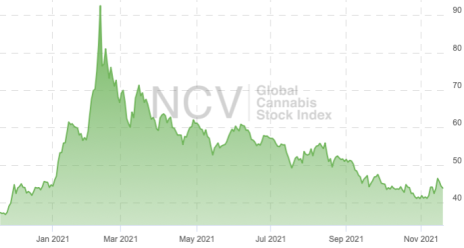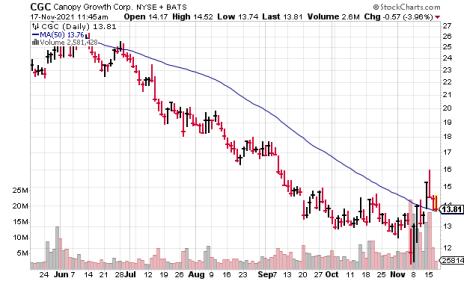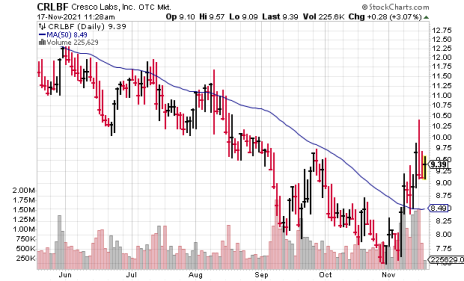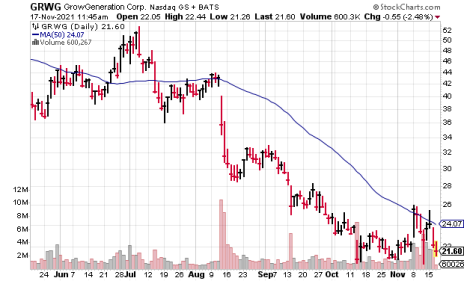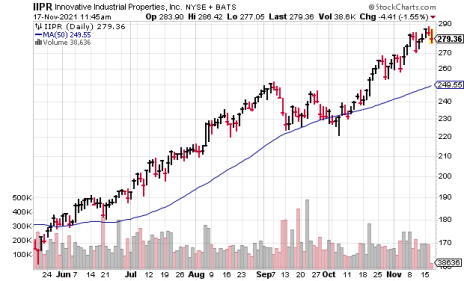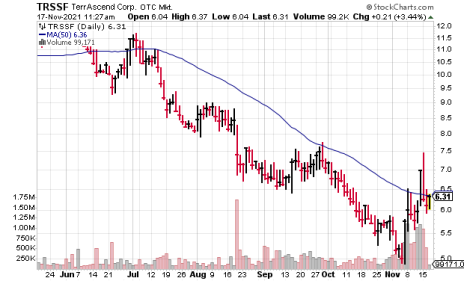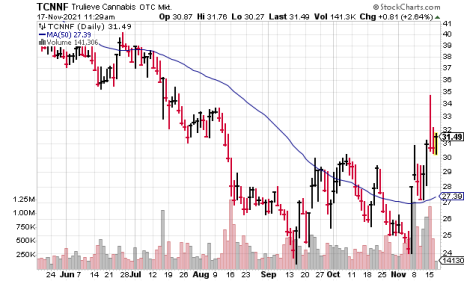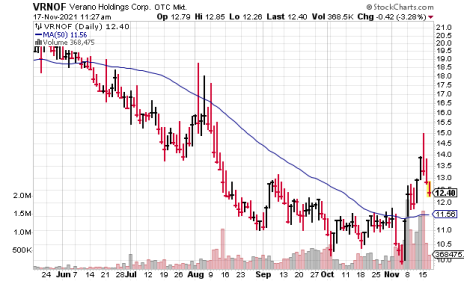This month’s issue of Cabot Marijuana Investor comes a week early, due to Thanksgiving holiday next week. And that’s good, because the sector is finally looking healthy again.
In last week’s update, I recommended averaging up in two stocks and buying two new stocks, and in this week’s issue, I give you the whole picture. It’s not too late to buy.
Full details in the issue.
Sector Overview
Buy the Rumor; Sell the News
The headline above refers to fact that the best time to buy is often when the notion that something may happen becomes prevalent—while the best time to sell is when the event actually occurs. The reason, of course, is that investors are always looking ahead—so by the time an event actually occurs, the effect of that occurrence has already been reflected in the price of the stock.
Case in point, the legalization of marijuana, which to date has occurred on a state-by-state basis in the U.S., while in Canada, the whole country went legal at once.
Those legalization events were all great news for the industry, but for investors, they were great times to sell and take profits.
Specifically, marijuana stocks peaked in January 2014, when marijuana was legalized in Colorado; marijuana stocks peaked in January 2018, when marijuana was legalized in California; and marijuana stocks peaked in October 2018, when marijuana was legalized in Canada.
Looking ahead, therefore, the odds are very good that stocks in the sector will peak when marijuana becomes legal in the U.S. at the federal level, and thus the best time to buy stocks in the sector is now, as discussion (chatter, rumor and general politicking) heats up about federal legalization.
The chatter at the moment is centered on South Carolina Republican Representative Nancy Mace, who this week introduced the States Reform Act, which would remove marijuana from the Controlled Substances Act while ensuring that businesses in states where marijuana is currently legal can continue to operate unimpeded by changing federal rules, and would establish a federal tax rate of 3%, down from 3.75% in an earlier version, and significantly lower than competing Democratic proposals.
Politics being what it is, there’s little chance of the act being passed as is. But seeing Republicans join the conversation is a great step in the right direction, and has given investors confidence that eventually, the government will get around to carrying out the will of the people, even though it’s not one of Joe Biden’s priorities. (In a recent Gallup poll, 68% of U.S. adults said they back legalizing cannabis—and that includes majorities of Democrats, Republicans and independents.)
In the meantime, the fundamentals of the industry remain strong, though the rapid growth of recent years is definitely slowing, as illustrated by the flood of recent third-quarter reports; only one of our producers cracked the triple-digit mark for revenue growth this time around. On the other hand, great progress is being made on other metrics as these businesses mature; as scale improves, margins are improving.
Most important of all, the stocks are finally acting well again, after a deep nine-month correction. Reasons, as mentioned last week, include the political action, the latest quarterly reports, and—not to be underestimated—that nine-month-correction that moved shares from weak hands to strong hands. The portfolio started buying again last Wednesday, averaging up in two existing positions and adding two new stocks, and is now 84% invested.
Marijuana Index
That nine-month correction was deep and damaging, but the action since November 5 has been very encouraging, with big moves on big volume telling us the buyers are once again in charge.
PORTFOLIO
| Stock | Shares | Current Value | Portfolio Weighting | Price Bought | Date Bought | Price 11/17/21 | % Change |
| Canopy Growth (CGC) | 1,096 | $15,338 | 3.7% | $6.95 | 08/22/17 | $13.99 | 101.3% |
| Cresco Labs (CRLBF) | 6,115 | $58,089 | 14.1% | $3.99 | 4/30/20 | $9.50 | 138.1% |
| Curaleaf (CURLF) | 5,411 | $54,919 | 13.3% | $4.76 | 12/20/18 | $10.15 | 113.2% |
| Green Thumb Ind. (GTBIF) | 2,051 | $48,130 | 11.7% | $7.25 | 04/30/20 | $23.47 | 223.7% |
| GrowGeneration (GRWG) | 873 | $18,883 | 4.6% | $4.33 | 12/20/19 | $21.63 | 399.5% |
| Innovative Ind. Prop. (IIPR) | 174 | $48,544 | 11.8% | $18.81 | 11/17/17 | $279.15 | 1384.1% |
| TerrAscend (TRSSF) | 2,926 | $18,345 | 4.5% | $4.79 | 10/7/20 | $6.27 | 30.9% |
| Trulieve (TCNNF) | 1,389 | $43,793 | 10.6% | $10.29 | 10/17/19 | $31.52 | 206.3% |
| Verano Holdings (VRNOF) | 1,457 | $18,073 | 4.4% | 13.86 | 11/10/21 | $12.40 | -10.5% |
| Village Farms (VFF) | 2,035 | $17,423 | 4.2% | 8.83 | 11/10/21 | $8.56 | -3.1% |
| Cash | $70,424 | 17.1% | |||||
| Total | $411,960 | ||||||
| YTD CHANGE | 1.0% | ||||||
| INDEX YTD CHANGE | -4.6% | ||||||
Note: The table reflects the state of the portfolio holdings before acting on any new recommendations.
What to Do Now
It’s time to start moving back into the sector. Focus on owning the leading stocks, and consider selling stocks you own that are not among the leaders. It’s still possible this rally will fail, and for that reason, we still have a little cash in the portfolio, but with a little more strength, I’ll happily move to fully invested.
New Recommendations
CURRENT RECOMMENDATIONS
Canopy Growth (CGC)
Canopy was the most popular marijuana company in the world a couple of years ago, but because the Canadian market didn’t grow as expected, all the Canadian stocks have retreated dramatically, and CGC is now off 75% from its all-time high. (Even worse is Tilray (TLRY), which is still on my watch list and is off 80%.) But the stock has been showing evidence of support over the past month, and as I write, it’s above its 25- and 50-day moving averages, which is encouraging. Canopy, remember, has the might of alcohol giant Constellation Brands (STZ) behind it, and lifestyle guru Martha Stewart on its gummies, so long-term prospects are good. But short-term, the company, like most of the Canadians, is still struggling to get back on the growth track. Third-quarter results saw revenues of $131 million, down 3% from the year before and a loss of three cents per share. The portfolio remains underweight in CGC. HOLD
Cresco Labs (CRLBF)
Chicago-based Cresco is one of the five leading marijuana companies in the U.S., with 40 operational dispensaries, 47 retail licenses and 20 production facilities in 10 operational states—as well as a brand-new flagship dispensary (under its Sunnyside brand) in its hometown of Chicago, just 300 feet from the Wrigley Field marquee. Cresco is the largest wholesaler of cannabis products in the U.S.—meaning it has a good chance to own the “Marlboro” of the industry. And it’s one of the cheaper stocks in the sector, as identified by Cabot’s own value expert, Bruce Kaser. Third-quarter results, released last Thursday, saw revenues hit $216 million, up 41% from the year before (but up only 2.6% sequentially). Adjusted EBITDA was $56 million, while EPS showed a loss of $0.10. And investors liked the news, as the stock has been trading higher since, well above both its 25- and 50-day moving averages. Our portfolio averaged up in the stock just before the report, and is now overweight in the stock. If you don’t own it, you can buy now. BUY
Curaleaf (CURLF)
Based in Massachusetts, Curaleaf remains the revenue king of the industry, but only by a hair! Third-quarter revenues were $317 million, up 74% from the year before and up 2% sequentially. (Trulieve, which has just merged with Harvest, reported combined revenues of $316 million). Adjusted EBITDA was $71 million, an increase of 69% from the year before, while cash flow from operations was $52 million, or 16% of revenue—all good—and the loss per share was 8 cents, up from a loss of 5 cents last year. Curaleaf now operates in 23 states with 109 dispensaries, 22 cultivation sites and over 30 processing sites, and it continues to grow by acquisition, so fundamentally, the picture is good. But technically, CURLF has yet to climb above its 50-day moving average, so I don’t rate it a buy here. The portfolio is already overweight in the stock. HOLD
Green Thumb (GTBIF)
Headquartered in Chicago, Green Thumb is one of the five U.S. industry leaders, with 16 manufacturing facilities and 65 operating retail locations in 14 states (California, Colorado, Connecticut, Florida, Illinois, Maryland, Massachusetts, Nevada, New Jersey, New York, Ohio, Pennsylvania and Virginia). And the company has now turned a profit for five consecutive quarters, which is impressive in this group. Third-quarter results, released last week, saw revenues of $234 million, up 48% from the prior year, and EPS of $0.09, up 125% from the year before. Like the other leaders, Green Thumb continues to grow by acquisition, and like the others, it has cash on hand to continue that practice—$285 million at the end of the quarter. As for the stock, it reacted well to the quarterly report, breaking out above its 50-day moving average, but has since dipped below it, and thus is not quite as strong as the leaders. So I won’t rate it buy, but I will hold our overweight position. HOLD
GrowGeneration (GRWG)
Based in Denver, GrowGeneration is not a marijuana company, but a hydroponic products retailer focused on serving commercial cannabis growers. The stock was a top performer coming into this year, but it’s really hit the skids in recent months, and is now 67% off its high, struggling to regain momentum; it was above its 50-day moving average briefly last week but has fallen back. Yet fundamental results remain strong: third-quarter results, released last week, saw revenues of $116 million, up 111% from the year before (making it the fastest-growing company in the portfolio), and EPS of $0.07, up 17% from the year before. There were four acquisitions in the quarter. And same-store sales, in the 25 stores that were open in the same quarter the year before, were up 15.7%. We can speculate about the reasons for the weakness (competition, reversion to the mean, investors’ preference for plant-touching stocks), but in the end, it’s the action of the stock that matters. For now we’ll hold our underweight position. HOLD
Innovative Industrial Properties (IIPR)
Our marijuana REIT, Innovative Industrial Properties, has been our other great diversification play, and this stock is still strong, hitting record highs in recent days! So why is IIPR strong while GRWG is weak? The main difference is yield; IPR pays a nice dividend. Third-quarter results, released two weeks ago, saw revenues of $53.9 million, up 57% from the prior year, and funds from operation (FFO) of $1.71, up 34% from the year before. And acquisitions, as always, continue at a good pace. As of November 3, 2021, IIP owned 76 properties located in Arizona, California, Colorado, Florida, Illinois, Maryland, Massachusetts, Michigan, Minnesota, Missouri, Nevada, New Jersey, New York, North Dakota, Ohio, Pennsylvania, Texas, Virginia and Washington, representing a total of approximately 7.5 million rentable square feet, which were 100% leased with a weighted-average remaining lease term of approximately 16.7 years. Our portfolio, which has taken profits in IIPR several times, is once again overweight in the stock because it keeps going up. It’s definitely the strongest stock in the portfolio. By some measures, it’s overvalued, but demand for yield is high these days and IIPR provides plenty of that. Just make sure you’re aware of the tax consequences of investing in a REIT before you buy. BUY
TerrAscend (TRSSF)
TerrAscend is a bit of a hybrid, with interests in both Canada and the U.S. Also, Canadian giant Canopy owns 29% of the company, in part because it will enable the Canadian giant a quick entry into the U.S. market when legal. As the smallest of the producers in our portfolio, the company has the potential to be a faster grower, but as the lowest-priced stock in the portfolio, it carries extra risk. Third-quarter results were released before the market open yesterday, and the results were mixed; revenues were $49.1 million, up 29% from the year before but down 16% sequentially, while adjusted EBITDA was $10.5 million, and cash on hand at the end of the quarter was $103 million, enough to support the company’s growth initiatives. As the for the stock, TRSSF climbed above its 50-day moving average for a couple of days last week, but has dropped back just below it since, and thus I’ll maintain my hold rating. The portfolio remains underweight the stock. HOLD
Trulieve (TCNNF)
While it has long been the biggest seller of marijuana in Florida, where it now has a 46% market share, Trulieve is now very close to being the biggest seller of marijuana in the world, thanks to its recent acquisition of Harvest Health & Recreation, which brings great strength in the western U.S. Combined third-quarter revenues, reported Monday, were $316 million and adjusted EBITDA was roughly $121 million. Trulieve’s results alone saw revenues of $224 million, up 64% from the year before and up 4% sequentially, and EPS of $0.14, down 7% from the year before. Cash on hand at quarter’s end was $213 million. Operationally, Trulieve stood out in the early years for its concentration on Florida, and today it stands out for its strategy of developing regional hubs (Florida, Pennsylvania and Arizona) that will likely enable improved efficiency and possibly a strategic advantage when national legalization arrives. As for the stock, it’s one of the stronger ones in the portfolio, jumping above its 50-day moving average on November 5 (the first big day of buying in the sector) and moving higher since. The portfolio averaged up last week and is now overweight. BUY
Verano Holdings (VRNOF), the fifth of the top five vertically integrated multistate operators, was a new addition to the portfolio last week. Headquartered in Chicago, the company has 89 retail locations in 11 states (Illinois, Florida, Arizona, New Jersey, Pennsylvania, Ohio, Nevada, Maryland, Massachusetts, Michigan, Arkansas) as well as 12 cultivation and production facilities. The company’s main brands are Verano (flower, pre-rolls, vapes and concentrates), Encore (gummies, hard candies, mints and chocolates), Avexia (the company’s medicinal brand, blending THC and CBD to alleviate pain and discomfort), Zen Leaf (retail dispensaries) and MÜV (medical dispensaries). The company has completed 13 acquisitions already, and will almost certainly complete more. Third-quarter results, released yesterday morning, saw revenues of $207 million, up 106% from the year before (making it the fastest-growing plant-touching company in the portfolio), and up 4% sequentially, and adjusted EBITDA of $111 million. When the company came public in April, the stock was at 20, but it’s bottomed at 10 a couple of times in the past month, and is now well above its 50-day moving average. Note: Verano was the featured buy in my Cabot Stock of the Week this Monday, in part because I think its youth (having just come public in April) means there are plenty of potential new buyers. BUY
Village Farms (VFF), headquartered in Canada, is a major grower of greenhouse vegetables (tomatoes and peppers and cucumbers, in particular), that has transitioned to the fast-growing cannabis industry. Its wholly owned marijuana subsidiary, Pure Sunfarms, is one of the largest producers in Canada—and one of the top-selling brands—and has been EBITDA positive since commencing sales in Q4 2018. In the U.S., mainly in Texas, the company has been focused on the CBD market, and in the past quarter acquired Balanced Health Botanicals, a cannabinoid platform with a top-five CBD brand. Third-quarter results, announced last week, saw revenues of $72.4 million, up 68% from the year before, while EPS was $0.01, unchanged from the year before. Our portfolio has owned VFF twice before, and last week we bought back in again, as the stock jumped above its 50-day moving average. This is unlikely to be as strong a stock as the hottest pure producers, but it does provide diversification. BUY
The next Cabot Marijuana Investor issue will be published on December 29, 2021.

